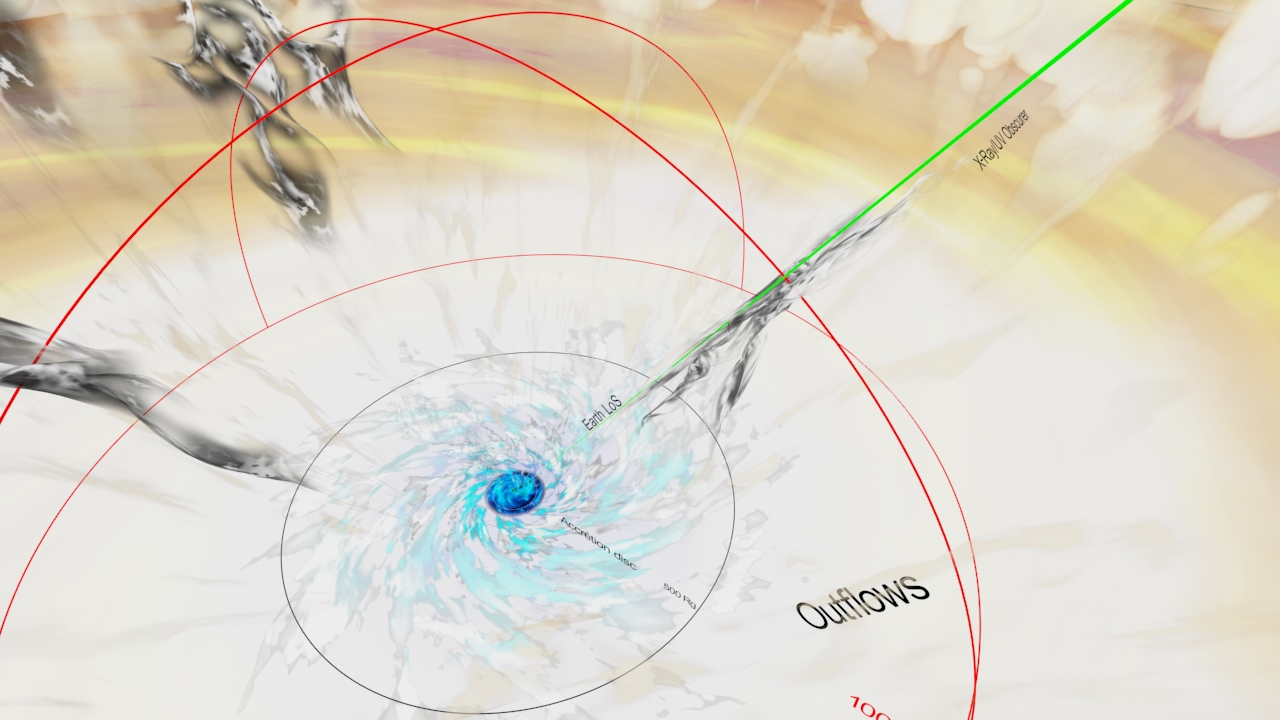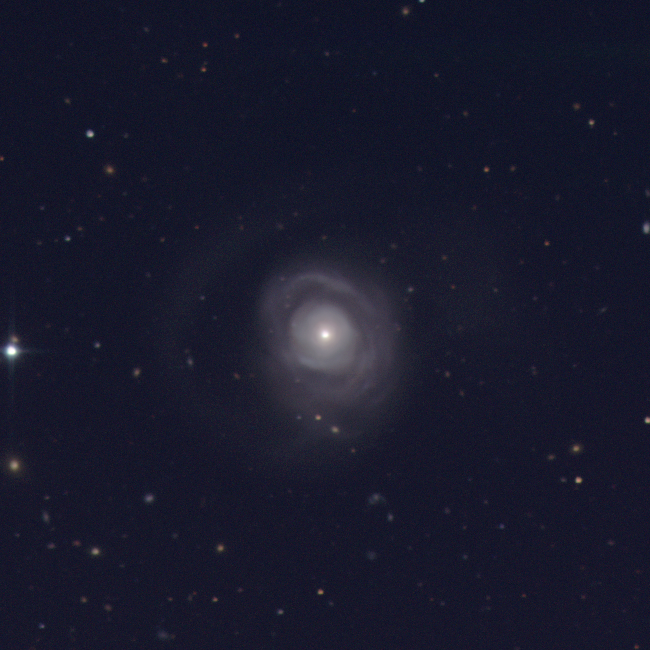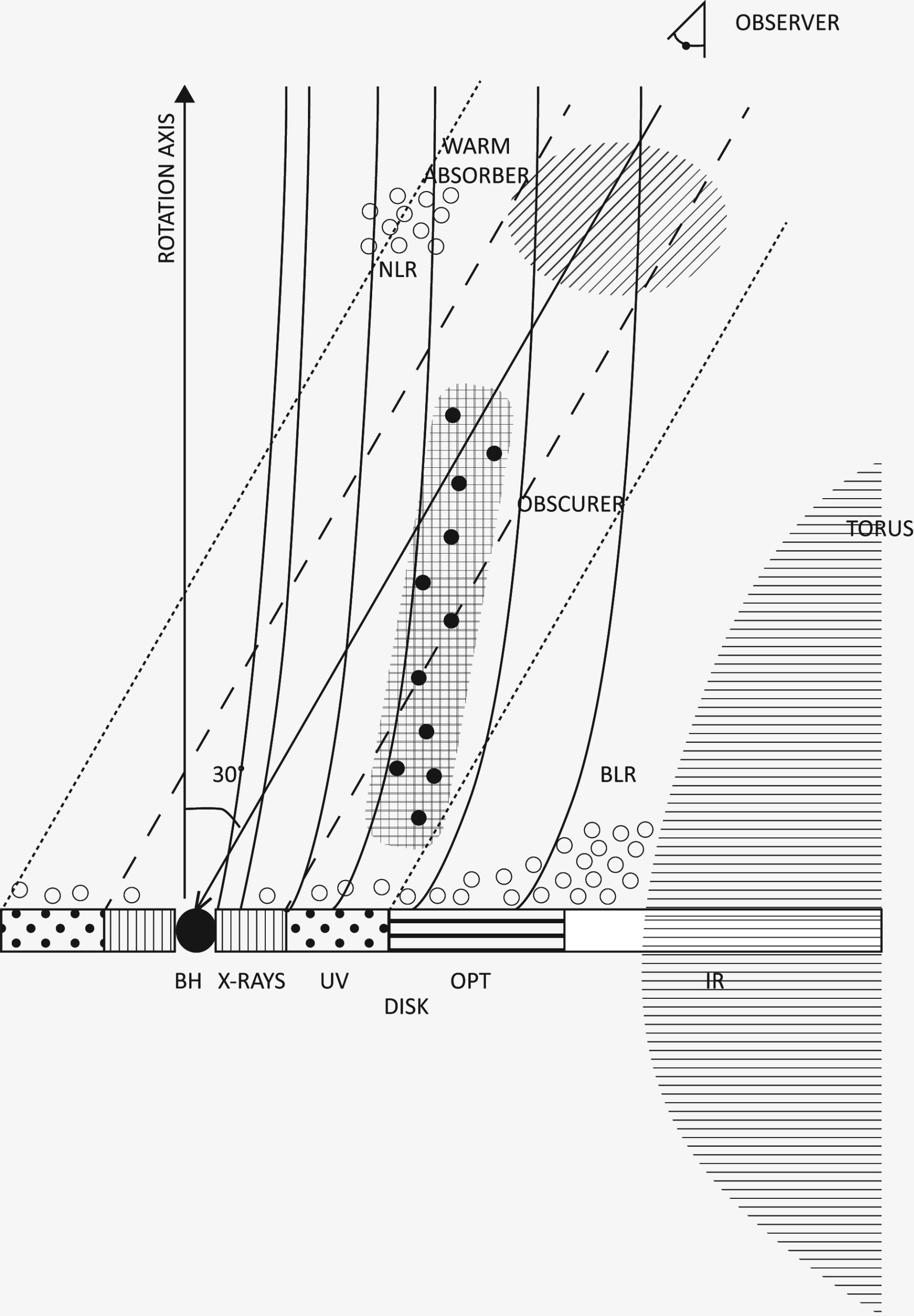An international team of astronomers has discovered that the supermassive black hole at the heart of the galaxy NGC 5548 has recently undergone strange, unexpected behavior rarely seen in the heart of active galaxies. The researchers detected a clumpy gas stream flowing quickly outward and blocking 90 percent of the X-rays emitted by the supermassive black hole at the center of the galaxy. This activity may provide new insights into the interaction of supermassive black holes and their host galaxies. The results have been published today in Science magazine.
This discovery was accomplished through an intensive observing campaign with the major ESA and NASA space observatories: XMM-Newton, the Hubble Space Telescope, Swift, NuSTAR, Chandra, and INTEGRAL. An international team led by scientist Jelle Kaastra, of the SRON Netherlands Institute for Space Research conducted the most extensive monitoring campaign ever of an active galaxy in 2013 and 2014.

“There are other galaxies that show gas streams near a black hole, but they haven’t changed as dramatically. This is the first time we’ve seen a stream like this move into the line of sight,” says Gerard Kriss of the Space Telescope Science Institute in Baltimore, Md. “We just happened to get lucky. With most objects like this, you don’t normally see this kind of event.”
The researchers say that this is the first direct evidence for the long-predicted shielding process that is needed to accelerate powerful gas streams, or “winds,” to high speeds. The team reports that this is a milestone in understanding how supermassive black holes interact with their host galaxies.
Winds
Matter falling onto a black hole gets heated and emits X-rays and ultraviolet radiation. The ultraviolet radiation can launch winds outward. The winds may be so strong that they can blow off gas that otherwise would have fallen onto the black hole. Black hole winds can therefore regulate both the growth of the black hole and its galaxy.
But the winds only come into existence if their starting point is shielded from X-rays. The newly discovered gas stream in the archetypal Seyfert galaxy NGC 5548 — one of the best-studied sources of this type over the past half-century — provides this protection. It appears that the shielding has been going on for at least three years.
Unexpected features
Right after the Hubble Space Telescope had observed NGC 5548 on June 22, 2013, the team discovered unexpected features in the data. “There were dramatic changes since the last observation with Hubble in 2011. I saw signatures of much colder gas than was present before, indicating that the wind had cooled down, due to a strong decrease of ionizing X-ray radiation from the nucleus,” Kriss said.
After combining and analyzing data from the six observatories, the team was able to put the pieces of the puzzle together. Supermassive black holes in the nuclei of active galaxies, such as NGC 5548, expel large amounts of matter through powerful winds of ionized gas. For instance, the persistent wind of NGC 5548, known for two decades, reaches velocities exceeding 1000 km/s.
Shielding

But now a new wind has arisen, much stronger and faster than the persistent wind. “The new wind reaches speeds of up to 5,000 kilometers per second but is much closer to the nucleus than the persistent wind,” Kaastra said. “The new gas outflow blocks 90 percent of the low-energy X-rays that come from very close to the black hole, and it obscures up to a third of the region that emits the ultraviolet radiation at a few light-days distance from the black hole.”
Because of this shielding, the persistent wind far away from the nucleus receives less radiation and cools down. Science paper co-author Nahum Arav said: “Because of this cooling down, new features arise in the Hubble spectrum of the wind. These features allow us to pinpoint the location of the strongest persistent wind component.”
Strong X-ray absorption by ionized gas has been seen in several other sources, and it has been attributed for instance to passing clouds. “However, in our case, thanks to the combined XMM-Newton and Hubble data, we know this is a fast stream of outflowing gas very close to the nucleus,” said team member Massimo Cappi. “It may originate from the accretion disk,” added team member Pierre-Olivier Petrucci.
An animated journey through the active galaxy NGC 5548
A movie by Renaud Person, one of the Worlds Director of the famous video game Assassin’s Creed © Ubisoft, brings us in a journey to the inner regions of NGC5548, and helps us in visualizing the findings presented in this study.
Further information
The results have been published in Science : A fast and long-lived outflow from the supermassive black hole in NGC 5548”, by Kaastra et al.
The team consists of Jelle Kaastra (SRON Utrecht, The Netherlands), Jerry Kriss (Space Telescope Science Institute, Baltimore, USA), Massimo Cappi (INAF-IASF Bologna, Italy), Missagh Mehdipour (SRON Utrecht, The Netherlands), Pierre-Olivier Petrucci (Univ. Grenoble Alpes, CNRS, France), Katrien Steenbrugge (Universidad Católica del Norte, Antofagasta, Chile), Nahum Arav (Virginia Tech, Blacksburg, USA), Ehud Behar (Technion-Israel Institute of Technology, Haifa, Israel), Stefano Bianchi (Università degli Studi Roma Tre, Italy), Rozenn Boissay (University of Geneva , Switzerland), Graziella Branduardi-Raymont (MSSL/UCL, Holmbury St. Mary, UK), Carter Chamberlain (Virginia Tech, Blacksburg, USA ), Elisa Costantini (SRON Utrecht, The Netherlands), Justin Ely (Space Telescope Science Institute, Baltimore, USA), Jacobo Ebrero (ESA, Spain), Laura Di Gesu (SRON Utrecht, The Netherlands), Fiona Harrison (California Institute of Technology, Pasadena, USA), Shai Kaspi (Technion-Israel Institute of Technology, Haifa, Israel), Julien Malzac (Université de Toulouse, France), Barbara De Marco (Max-Planck-Institut für extraterrestrische Physik, Garching, Germany), Giorgio Matt (Università degli Studi Roma Tre, Italy), Paul Nandra (Max-Planck-Institut für extraterrestrische Physik, Garching, Germany), Stéphane Paltani (University of Geneva , Switzerland), Renaud Person (St. Jorioz, France), Brad Peterson (Ohio State University, Columbus, USA), Ciro Pinto (University of Cambridge, UK), Gabriele Ponti (Max-Planck-Institut für extraterrestrische Physik, Garching, Germany), Francisco Pozo Nuñez (Ruhr-Universität Bochum, Gernmany), Alessandra De Rosa (INAF/IAPS, Roma, Italy), Hiromi Seta (Rikkyo University, Tokyo, Japan), Francesco Ursini (University of Grenoble, CNRS, France), Cor de Vries (SRON Utrecht, The Netherlands), Dom Walton (California Institute of Technology, Pasadena, USA), Megan Whewell (MSSL/UCL, Holmbury St. Mary, UK).


